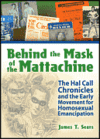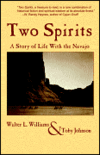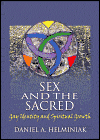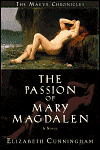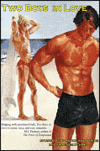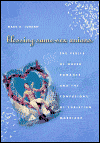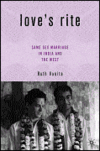 Love’s Rite:
Love’s Rite:
Same-Sex Marriage in India & the West
By Ruth Vanita
Palgrave Macmillan
ISBN: 1403970386288 Hardcover, $6
Reviewed by Amara Das Wilhelm
Love’s Rite: Same-Sex Marriage in India and the West is an exciting new book by University of Montana professor Ruth Vanita. No longer simply a debated concept, same-sex marriage is fast becoming a reality in Hinduism today—both in India and the West. Hundreds of gay and lesbian Hindu couples are literally “tying the knot” in wedding ceremonies both public and private, with family approval or not, and increasingly with the blessings of officiating Hindu priests. In her latest book to date, Vanita examines this phenomenon from a religious, social and more importantly, human perspective.
While most Hindus remain opposed to same-sex unions and have not thought about the topic very deeply or on a personal level, this is changing. For instance, when a Shaiva priest from India was asked to perform a wedding for two women in 2002, he hesitated at first but then agreed. Vanita: “He told me that when the women requested him to officiate at their wedding he thought about it and, though he realized that other priests in his lineage might disagree with him, he concluded, on the basis of Hindu scriptures, that, ‘marriage is a union of spirits, and the spirit is not male or female.’”
Srinivasa Raghavachariar, a well known Sanskrit scholar and Hindu priest of the major Vaishnava temple in Srirangam, India, deliberated upon the same issue and came up with a similar response: “Same-sex lovers must have been cross-sex lovers in a former life. The sex may change but the soul remains the same in subsequent incarnations, hence the power of love impels these souls to seek one another.”
Swami Bodhananda Saraswati, a Vedanta master who took sannyasa initiation from Swami Chinmayananda and is the founder of the Sambodh Foundation with branches worldwide, had this to say on the subject of same-sex marriage: “There is no official position in Hinduism. From a spiritual or even ethical standpoint, we don’t find anything wrong in it. We don’t look at the body or the memories; we always look at everyone as spirit…Different priests may or may not perform same-sex weddings—it is their individual choice because there is no one position or one head of Hinduism. I am not opposed to relationships or unions—people’s karma brings them together.”
Ruth Vanita also quotes Swami B.V. Tripurari, a sannyasi in the Gaudiya Vaishnava tradition: “My opinion regarding gay and lesbian devotees is that they should be honored in terms of their devotion and spiritual progress. They should cultivate spiritual life from either a celibate status, or in something analogous to a heterosexual monogamous situation…Although my Guru Maharaja (Srila Prabhupada) frowned on homosexuality in general, he was also very practical, flexible, and compassionate. One of his earliest disciples was a gay man who once related how he had ultimately discussed his sexual orientation with Srila Prabhupada. He said that at that point Srila Prabhupada said, ‘Then just find a nice boy, stay with him and practice Krishna consciousness’…I believe that Hinduism originally held a much more broadminded view on sexuality than many of its expressions do today.”
Of course, not all opinions are so favorable and open-minded. Swami Pragyanand of Avahan Akhara, for instance, had this to say for a reporter from the Hinduism Today newspaper: “Gay marriages do not fit with our culture and heritage. All those people who are raising demand for approving such marriages in India are doing so under the influence of the West…we do not even discuss it.” The diverse nature of Hinduism allows adherents to agree or disagree on this controversial issue. Quite often, members of the same organization or temple will have varying opinions. This is an advantage for gay Hindus who can then “vote with their feet” by avoiding priests with negative attitudes, such as the one above, and seeking out those with more compassionate and inclusive viewpoints.
Love’s Rite presents a refreshing array of new and encouraging material that will help this emerging debate along. It is well written and thorough, covering all areas of discussion, but at the same time quite easy to read. Divided into ten chapters, Love’s Rite explores such interesting questions as—How is marriage defined, now and in the past? Who defines it? What are the differences between marriage in India and the Euro-American West? Is the spirit gendered? What are the differences between marriage and friendship? Who is qualified for child rearing? What happens to couples when they are forcibly separated or pressured into unwanted marriages? All of these questions are thoroughly addressed in Vanita’s new book.
The personal dimension of Love’s Rite is enormously moving. In particular, Vanita examines the recent phenomena of joint suicides in India committed by (mostly) female couples encountering violent opposition to their relationships. In the following example, a poverty-stricken lesbian couple on the verge of suicide bequeaths their last few rupees to the local Krishna Deity: “Among the items Lalitha and Mallika left behind was a greeting card showing a man and a woman kissing in silhouette against a sunset. This card was not new; someone else had already used it. Mallika had pasted a piece of paper over the sender’s name and written her own name on the paper. Inside was her message to Lalitha, giving her ‘a thousand kisses in public.’ Lalitha’s note also stated, ‘The Rs. 25 placed in the diary is to be given as offering to Guruvayoorappan.’ Guruvayoorappan refers to the icon of Krishna in the temple at Guruvayoor, a famous temple town and pilgrimage site very close to the girls’ hometown, Trichur.”
Another incident occurred at a yoga center in Tamil Nadu: “Sumathi, 26, and Geetalakshmi, 27, had been living at a Yoga Centre in Coimbatore, Tamil Nadu, for three years. Since they were somewhat beyond the conventional age for marriage, and were living away from their parents, it appears that their religious way of life allowed them to remain respectably single. But the people at the Yoga Centre found out about their intimate relationship, and threw them out. They had to part and return to their parental homes. Unable to bear separation, they decided to commit suicide. In a letter to their guru at the Centre, they wrote, ‘We did a mistake because of which you threw us out…We cannot survive in this society. That is why we arrived at this decision. Please forgive us.’”
Not all of the relationships end so tragically, though, especially when they gain the support of their families and local villages. Vanita notes that in India, custom and community support far outweigh any legal validity—in fact, unlike the West, Indian law does not require marriage licenses, whether for the couple or officiating Hindu priest, and the majority of marriages conducted in India are not directly registered with the state. The importance of family and community support in India cannot be underestimated and is something that is slowly increasing: “More intriguing than parents who oppose same-sex marriage are those who come around to supporting it. Newspaper reports represent several parents participating in their daughter’s weddings. In some cases, the weddings appear to have been elaborate affairs, attended by many guests. In none of these cases was any gay rights movement or organization involved. The arguments that convinced these parents were not, then, those that might have been put forward by gay rights advocates. The family members quoted in the newspaper reports represent themselves as wanting to make their daughters happy, and becoming convinced that they would be happy only if they married one another.”
Love’s Rite offers several examples of same-sex Hindu marriages performed in both India and the West, along with heartwarming photos of the happy couples and their weddings. Some of the ceremonies are private while others are lavish celebrations attended by many relatives and friends. Most of the weddings make use of traditional Hindu rites such as invoking fire as a witness, exchanging garlands and vows, chanting sacred mantras, tying garments together, taking seven steps around the fire, and so on. In 2001, a Hindu priest of the Srivaishnava lineage conducted a commitment ceremony for a Hindu lesbian couple in Sydney, Australia. He mentioned that in the Ramayana, a partnership ceremony between Lord Rama and Sugriva is described whereby Hanuman lights a fire and the two friends exchange vows, circle the fire together, etc.—very similar to a Vedic marriage ceremony. The priest was of the opinion that such a ceremony was appropriate for gay couples. Other Hindu priests model their same-sex weddings after more traditional Hindu gandharva or vivaha types.
The book contains many nice summaries of Hindu tradition and philosophy, especially in regard to ancient textbooks and their many gender-bending narrations involving Hindu deities. In Chapter Five, the reader is treated to not one but three renditions of the story of Maharaja Bhagiratha’s miraculous conception by two females—a Bengali edition of the Padma Purana and two separate versions of the Krittivasa Ramayana. In Chapter Eight, there is an interesting examination of same-sex love between females as recorded in Rekhti, Indo-Muslim literature from the eighteenth and early nineteenth centuries. Using these and other textual references such as Kama Sutra and the Puranas, Vanita demonstrates how same-sex love and unions are by no means anything new to the Indian subcontinent.
In Chapter Seven, Love’s Rite explores the modern-day marriage arrangements in India of gay men and lesbians to opposite-sex partners. Vanita writes: “It is well known that in India and other supposedly traditional societies, large numbers of people live as apparently traditional heterosexuals, while secretly engaging in homosexual liaisons or leading lives of quiet desperation. That the same is true in the West is less often acknowledged because many people assume that the openly gay community is synonymous with the entire gay population. In fact, this is very far from being the case.” My one critique of this section is that Vanita fails to provide any scriptural evidence supporting or contradicting this modern day practice. For instance, the Hindu concept of svadharma, or living according to one’s own nature and duty (as mentioned in Bhagavad Gita), seems to disagree with it, and verses forbidding the marriage of homosexual men to women can be found in Hindu texts such as Narada-smriti. The story of goddess Bahucara, who curses her husband for dishonestly marrying her (he refuses her love and goes to other men instead), also comes to mind. Nevertheless, Vanita recognizes the embedded tradition as highly questionable: “While demonstrating that same-sex desire has existed in the past and still does exist within traditional families, I do not mean to suggest it flourishes there. Among the gay Indians I know who have entered heterosexual marriage without telling their spouses, almost all have been plagued by fear, guilt, shame or regret…The few exceptions are those where both spouses are bisexual, or one is heterosexual and the other gay or bisexual, but they reach a mutual agreement not to be monogamous. I do not have the data to examine the relative happiness of MOCs [marriages of convenience].”
Undoubtedly, this book will greatly assist anyone wishing to better understand the difficult and complicated topic of same-sex marriage from a Hindu perspective. For most, the question will not be solved until one day, at some point in time, a dearly beloved friend or relative faces this issue in the most personal of ways. This is exemplified by a soul-searching swami in the book’s final chapter: “A couple of years ago, an eastern European devotee named Damodara hanged himself in a Vaishnava ashram in the US, after an Indian ashram had cancelled his trip to India when they found out he was gay. Gaudiya Vaishnava monk Bhakti Tirtha Swami, wrote a soul-searching letter: ‘Recently, I have been making so much more effort in trying to open up my heart to be more available in understanding and serving all Vaishnavas…After hearing of Damodara’s suicide…I must say that I have seen the light…’” Another swami, Bodhananda Saraswati, reveals a similar mood: “We have to face this issue now…I’m sure spiritual persons will have no objection when two people come together. But it is a social stigma…So what is required is a debate in society. I have not debated it enough. I have to do that. I have a lot of people confiding in me, ‘I am very worried. I am gay. What should I do now?’”
In the beginning of her book, Ruth Vanita quotes San Francisco mayor Gavin Newsom, who, while presiding over that city’s civil disobedience against California’s discriminatory marriage laws in 2004, said: “Put a human face on it. Let’s not talk about it in theory. Give me a story. Give me lives.” In this light, I offer many thanks and pranams to Ruth Vanita for doing just that—she addresses the important debate of same-sex marriage in her new book, Love’s Rite, from a perspective that is not only scholarly but deeply personal.
Amara Das Wilhelm is a Gaudiya Vaishnava monk and author of the book, Tritiya-Prakriti: People of the Third Sex.
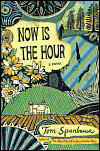 Now Is the Hour
Now Is the Hour
